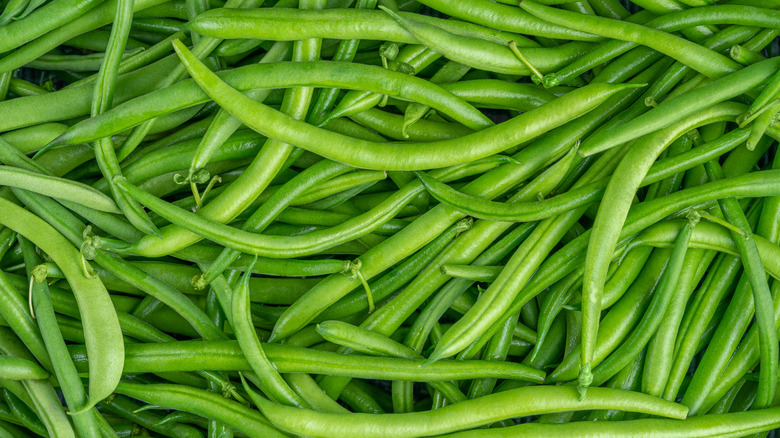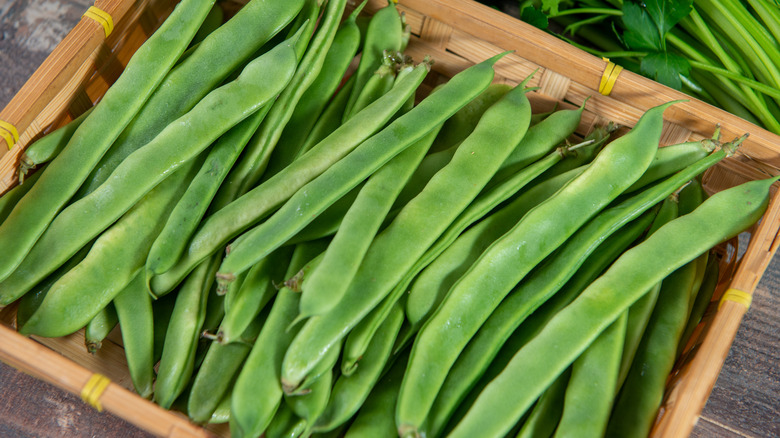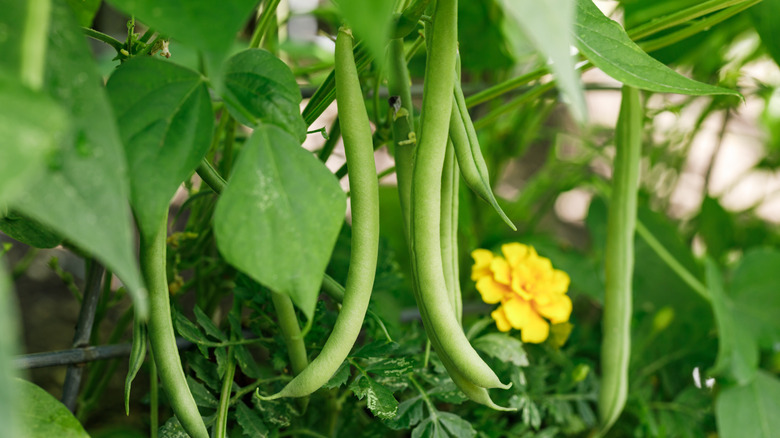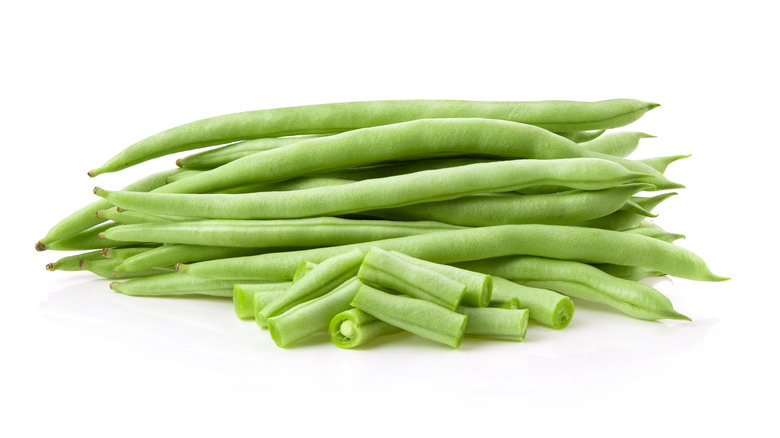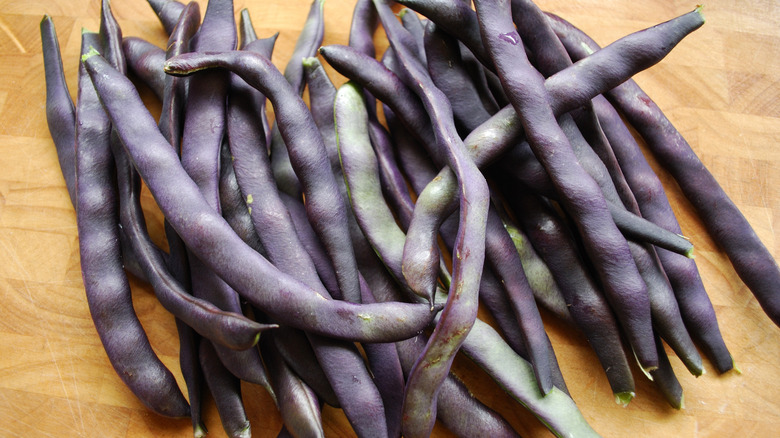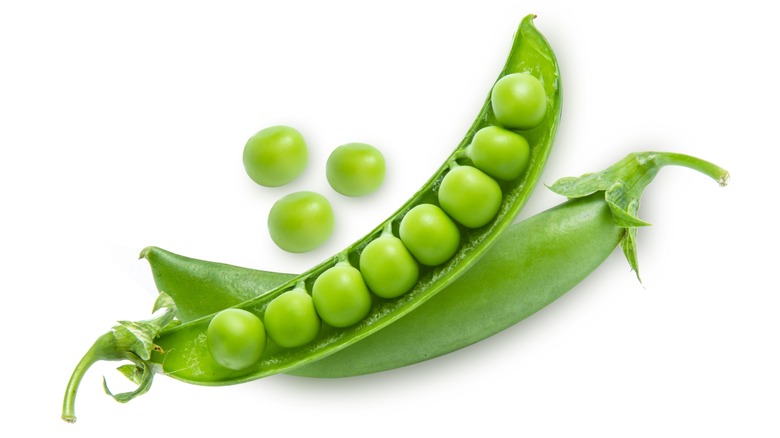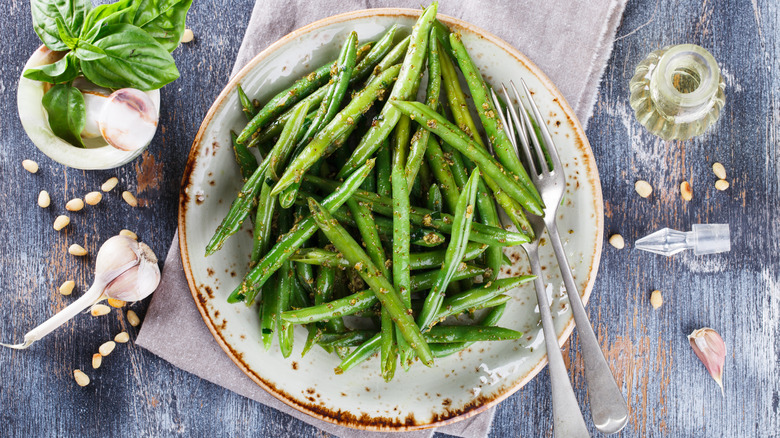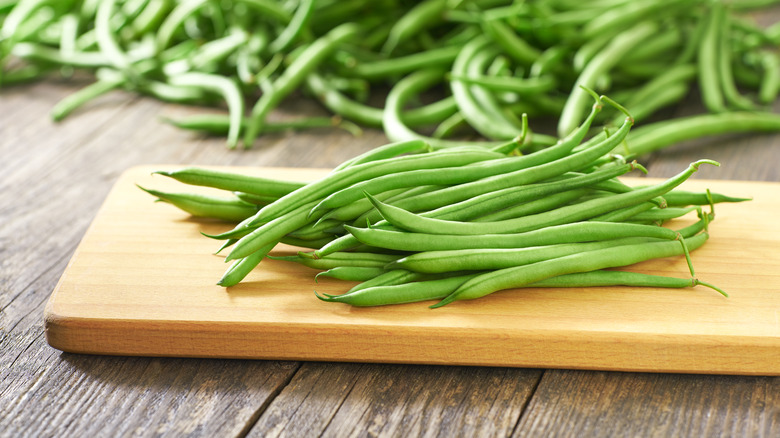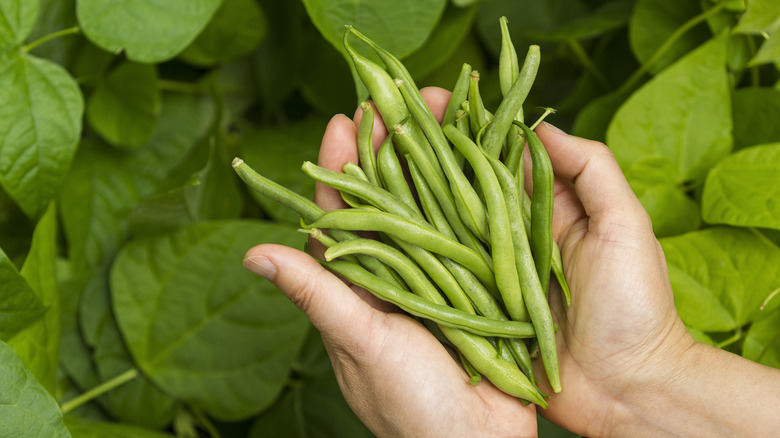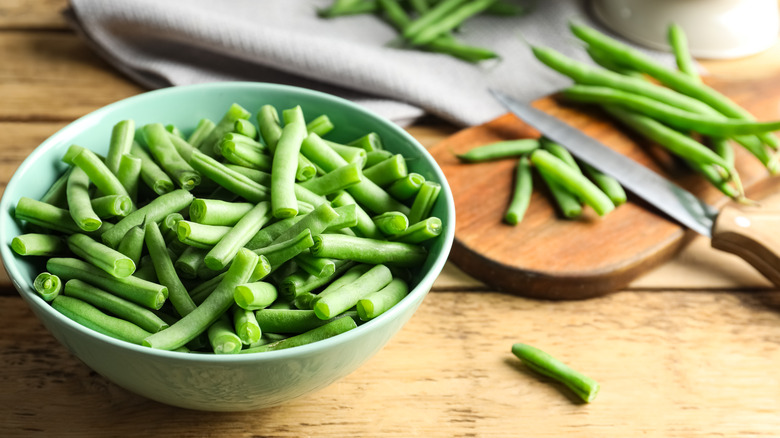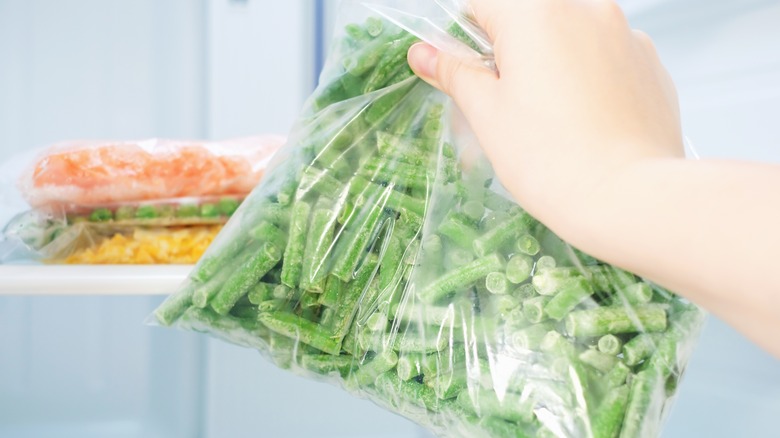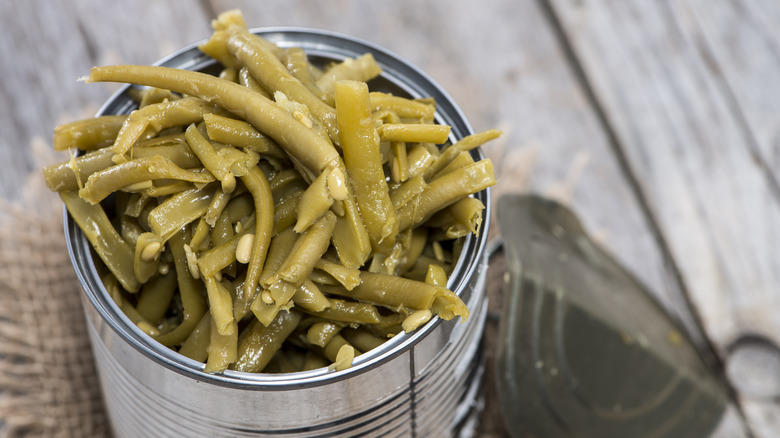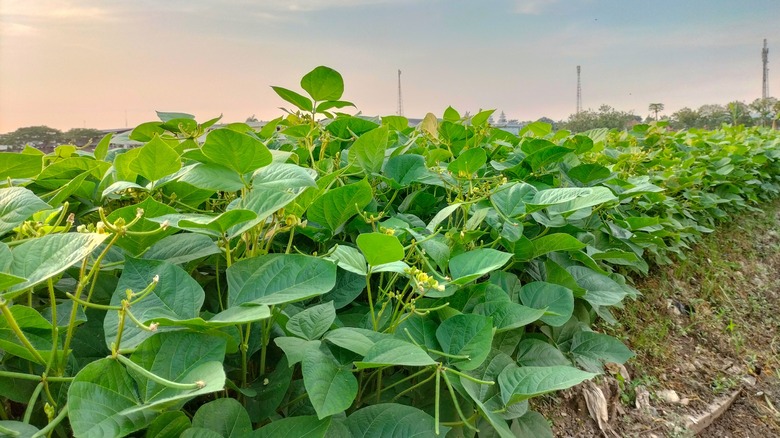False Facts About Green Beans You Thought Were True
With their distinctive slender pods and pleasing crisp texture, green beans are a popular addition to our dinner plates. These little green beauties were voted the fourth most popular vegetable in America in 2023, according to data collected by YouGov, and the iconic green bean casserole is a much-loved addition to the Thanksgiving table for many people each year.
Green beans may have a humble reputation, but there's more to these delicious veggies than first meets the eye. Behind the unassuming green bean pod sits an array of misconceptions, and we're here to separate the fact from the fiction. From false beliefs about certain varieties to assumptions regarding their uses in the kitchen, there is more misinformation surrounding green beans than you might have first guessed. But fear not, because we're here to set the record straight.
Join us as we disprove 12 common falsehoods about green beans, shedding light on their production, prep methods, nutritional benefits, and more. Prepare to expand your knowledge and get clued up on these nutritious legumes.
False: There's only one variety
Contrary to popular belief, there isn't just one type of green bean. Green beans encompass a wide range of varieties, or cultivars, that have been selectively bred over centuries. From wax beans to haricot verts, long beans to romano beans, there are over 130 types of green beans out there. Thankfully for those of us with decision paralysis, you are unlikely to be faced with this level of choice at the grocery store! The most common type of green beans found in supermarket produce sections are members of the species Phaseolus vulgaris. These are the classic long, slender, rounded beans with that distinctive bright green color.
These varieties can include the popular haricot vert and the romano beans. Haricot verts, also known as French green beans, are particularly slender and delicate. These beans are harvested young, giving them a tender texture and subtle sweetness. Romano beans, also known as Italian green beans or flat beans, feature a broader and tougher pod with a rich, nutty flavor.
False: They all grow the same way
When you think of a green bean plant, you might picture long vines climbing high as they wind their way up a wooden pole. This is certainly accurate for many types of green beans, but did you know that some varieties grow no higher than a few feet off the ground?
Green beans generally fit into one of two categories — pole beans and bush beans. Pole beans require support from a pole or trellis for the vines to climb and can reach up to 15 feet in height, with pods sprouting from top to bottom. Bush beans, on the other hand, do not require support to grow and reach a maximum height of just two feet.
Bush beans tend to be lower maintenance and take less time to harvest. However, they also have a shorter harvesting window than pole beans, with the produce typically appearing in one fruitful, short burst. Pole beans will yield for a longer period, and also are more resistant to disease. But, thanks to their climbing nature, they require a little more maintenance.
False: String beans aren't green beans
There is often confusion in the culinary world that string beans are a separate entity from green beans. In reality, string beans and green beans are the same thing.
Historically, many green bean varieties possessed tough, fibrous strings that needed to be removed before cooking which gave rise to the name. However, modern breeding efforts have largely eliminated the strings from commercial green bean varieties. Despite this, the name stuck around, leading to the misconception that string beans were a distinct type of bean. Today, the names green bean and string bean can be used interchangeably, with both referring to the widely available slender, rounded beans.
Some heirloom varieties of green beans still retain their fibrous strings, but these are much rarer and are generally only found at specialty stores or markets. These true string beans require a bit of extra preparation, as the strings must be removed before cooking. However, it's important to note that heirloom string beans are still not a separate species, just another of the many varieties of green beans.
False: They're always green
The name of this versatile veggie suggests color uniformity. However, green beans come in a spectrum of hues beyond the traditional green. If you're looking to experiment with flavors and amp up the visual appeal of your home cooking, then there reality is that there are plenty of vibrant varieties to try.
One of the most striking variations is the purple green bean. These beans have a subtle nutty and earthy flavor and are a little sweeter than the green variety. In addition to their aesthetic appeal, purple beans also provide some unique nutritional benefits. The pigments responsible for their vibrant hue, called anthocyanins, have antioxidant properties associated with a variety of health benefits, including reduced inflammation and the possible prevention of cancers. When cooked, that purple hue will likely disappear, while the anthocyanins may also degrade in the process, as researchers found in a 2014 study published in the Journal of the Science of Food and Agriculture.
Meanwhile, yellow wax beans are a sunny alternative to traditional green beans, with pods that range from pale yellow to golden. This is because the beans don't contain chlorophyll, which gives other varieties their green coloring. Wax beans tend to be very similar in flavor and texture to their green cousins, making them an effective substitute in everyday cooking.
False: They have peas in them
While green beans and peas may often find themselves side by side on the dinner plate, they are distinct vegetables with unique characteristics. Both are legumes, along with lentils and chickpeas, among others. But, when you slice a green bean open, you'll see only its seeds, which are not the same as your traditional garden peas. Green bean pods are harvested while still immature, before the seeds inside have fully developed, giving them their characteristic tender bite.
Typical garden peas, on the other hand, are harvested when the pods are fully mature, with the seeds, or peas inside having reached their peak size and flavor. Picking them at just the right time helps to give them their distinct plump texture and sweet taste.
There are also distinct differences in the way these two plants grow. Green beans thrive in the warmer temperatures of summer, while peas prefer a cooler environment. Although both varieties can have climbing plants, the stems of pea plants don't wrap their way around the support pole or trellis like green beans do. Instead, they have structures called tendrils that grab onto the support.
False: They're boring
If you think green beans are a dull or unexciting vegetable, think again. While they may not boast the bold flavors of some other foods, their subtle sweetness and incredibly versatile nature make them a great staple in your kitchen.
Green beans are often served boiled or lightly steamed, which can be a simple and effective way to enjoy them. But, there are plenty of other delicious possibilities when it comes to incorporating them into your cooking. Try sautéing green beans with garlic and butter for a simple yet flavorful side dish that's finished off with a squeeze of zesty lemon juice. Furthermore, green beans pair well with a wide range of herbs like parsley, basil, and rosemary, as well as spices like chili powder, paprika, and cumin. Roasting beans in the oven or cooking them in the air fryer are also great ways to bring out their natural sweetness, giving the veggies a tender and caramelized finish.
You can also incorporate green beans into stir fries, salads, casseroles, sheet pan dinners, soups, and more for added texture and nutrition. A popular Japanese technique calls for coating green beans in tempura batter and deep frying them until wonderfully crispy. With a bit of creativity, green beans can be transformed into a multitude of tasty dishes that are anything but boring.
False: They're only high in vitamin C
Green beans are indeed a great source of vitamin C, but the wide array of other nutrients they offer can get overlooked. Green beans have an incredibly diverse nutritional profile that makes them a valuable addition to any meal. As well as vitamin C, green beans are rich in both vitamin K and calcium, two nutrients essential for good bone health. They also contain significant amounts of folate, a B vitamin important for the formation of red blood cells in the body, and potassium, which plays a crucial role in maintaining healthy muscle and nerve function.
Furthermore, green beans are low in calories and fat but high in fiber. This makes them a great option for those looking to maintain a healthy weight or improve digestive health. The fiber in green beans means they'll help to leave you feeling satiated while regulating blood sugar, reducing inflammation, and supporting a healthy gut microbiome.
Green beans are also packed with antioxidants, including quercetin and flavonols, as well as anthocyanins in the purple varieties. These help to protect the health of cells in our bodies and may reduce the risk of chronic diseases such as cardiovascular diseases and cancers.
False: They're hard to grow yourself
With green beans so readily available at the grocery store, you might think that growing them yourself isn't worth the hassle. But, green beans are one of the most beginner-friendly vegetables for home gardeners. With the right conditions and minimal maintenance, you can enjoy a harvest of fresh green beans from your own backyard.
Green beans are adaptable plants that thrive in a variety of climates. They prefer well-drained soil and plenty of sunlight, so be sure to choose a sunny spot in your garden for planting. The plants can be sensitive to frost, so it's best to plant them in spring or once temperatures are consistently well above freezing.
If you're growing pole beans, plant them around a support pole or trellis (three to four seeds per support). If they're bush beans, they can grow without the need for support, with seeds planted about 1.5 inches deep and spaced at least 3 inches apart. Once the seedlings have been sown, it's simply a case of keeping them topped up with water (about 2 inches per week) and waiting for the green beans to sprout. Bush beans will be ready to pick in about 50-55 days, but pole beans take a little longer — about 55-60 days.
False: Both ends need trimming
Trimming the ends of green beans is a common practice in many kitchens, but this isn't always necessary. Only one end of the green bean typically needs to be trimmed, the tougher stem end of the green bean where it attaches to the plant. You'll notice this part has a thicker texture and maybe a small piece of stem still attached. That should be removed before cooking.
The opposite end is usually tender and fine to eat, meaning there is no real need for trimming — removing it would be purely for aesthetic reasons. So, leave it intact if you can to minimize food waste. To trim the tops of your green beans, first take a handful and place them on a chopping board. Arrange them so the ends are nicely lined up, then make one clean cut with a sharp knife — remember, using a dull knife can be a dangerous cooking mistake — to remove them all in one go.
False: They're not easy to store
You might think that green beans are difficult to store for extended periods. But, with the correct handling and storage techniques, green beans can stay fresh and flavorful for longer. The key to storing green beans successfully is keeping them cool and dry. Store fresh green beans in the crisper drawer of your refrigerator, where the temperature and humidity are ideal for preserving freshness. It's best to keep them in their packaging or pop them in a plastic food bag if they are loose. Stored this way, green beans should keep well in the fridge for up to one week.
To prolong their shelf life, freeze green beans for long-term storage. To do this, first, trim the tough ends of the beans, then give them a quick blanch in boiling water, followed by an ice bath to halt the cooking process. Once trimmed and blanched, the beans can be frozen in airtight containers or freezer bags for up to one year.
Another option is to preserve your green beans in jars. For the canning method, chop the beans into bite-sized pieces and add them to a sterilized jar along with some boiling water and canning salts. Then, they will need to be placed in a pressure canner to cook. Alternatively, you can pickle green beans in a mixture of boiling water, vinegar, sugar, salt, and spices, with no need for pressure cooking.
False: Canned green beans contain fewer nutrients
There's a common misconception that canned green beans are not as nutritious as their fresh counterparts. However, canned varieties can still offer very similar benefits when it comes to valuable vitamins, minerals, and fiber.
Canned green beans are typically harvested and processed at peak ripeness, locking in their nutritional value at the time of canning. This means they still pack a healthful punch, making canned green beans both a convenient and budget-friendly option for adding veggies to your diet.
Canned beans do have a slightly different texture than fresh beans, being softer and less crisp, but there are plenty of ways to jazz them up with seasonings and different cooking methods. They also tend to have higher sodium due to the salts used in their preservation. To reduce this high salt level, give the canned green beans a thorough rinse under cold water before using.
False: The US is the biggest producer of green beans
Despite its agricultural sector, you might be surprised to learn that the United States is not the largest producer of green beans across the globe. While green beans are indeed a significant crop in the U.S. and American-grown beans account for a substantial portion of their production, other countries surpass the U.S. when it comes to producing this crop.
The leading producer of green beans is China, which according to Global Trade, produces a whopping 21 million tons of these veggies every year, in large part due to the plentiful land it has available for agriculture. China currently produces over 75% of all the world's green beans.
Taking second place in the green bean production rankings is Indonesia, with a yearly yield of 946,000 tons. The U.S. sits in the third spot, producing 813,000 tons and holding just a 3% share in global green bean production.
